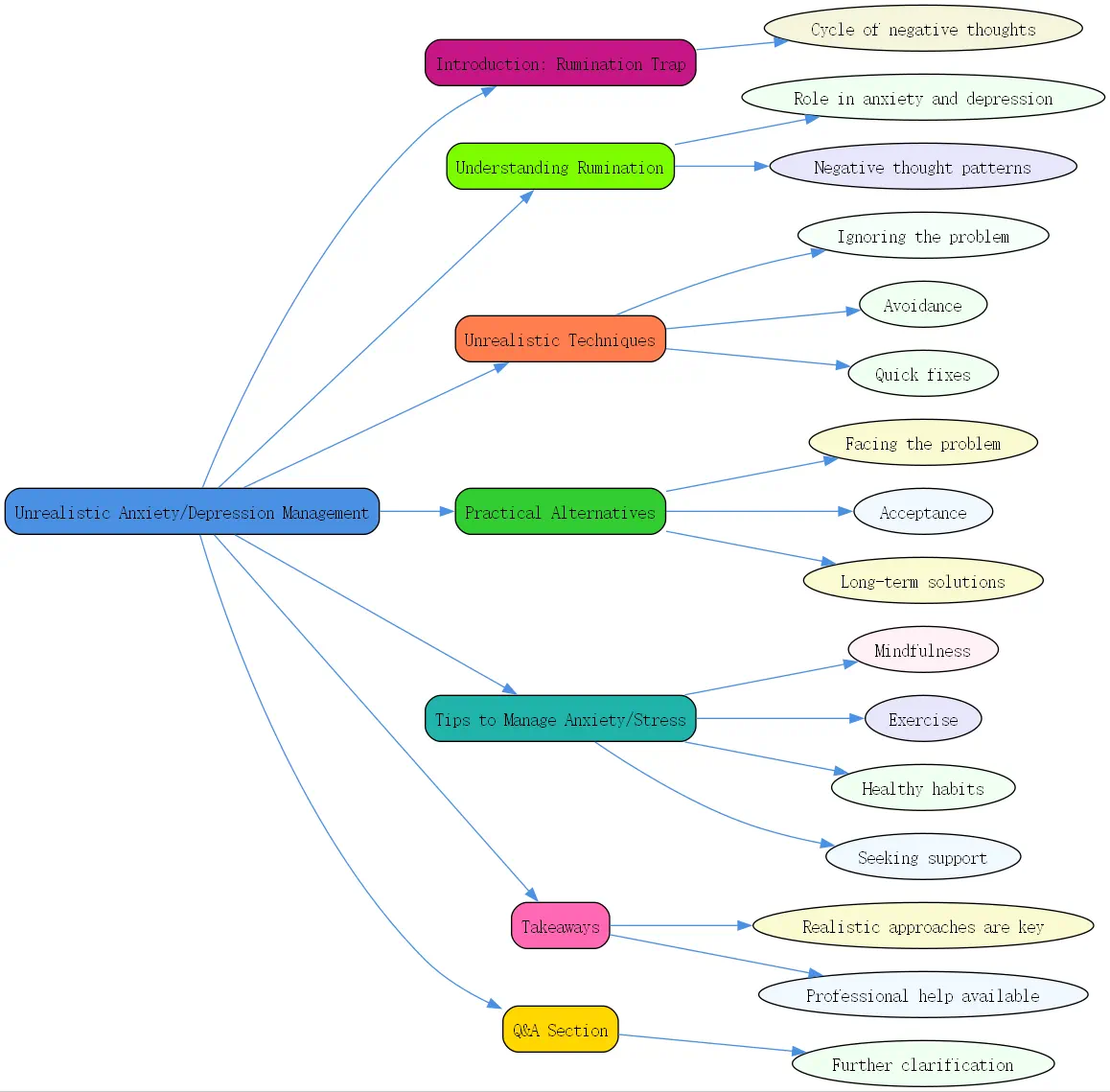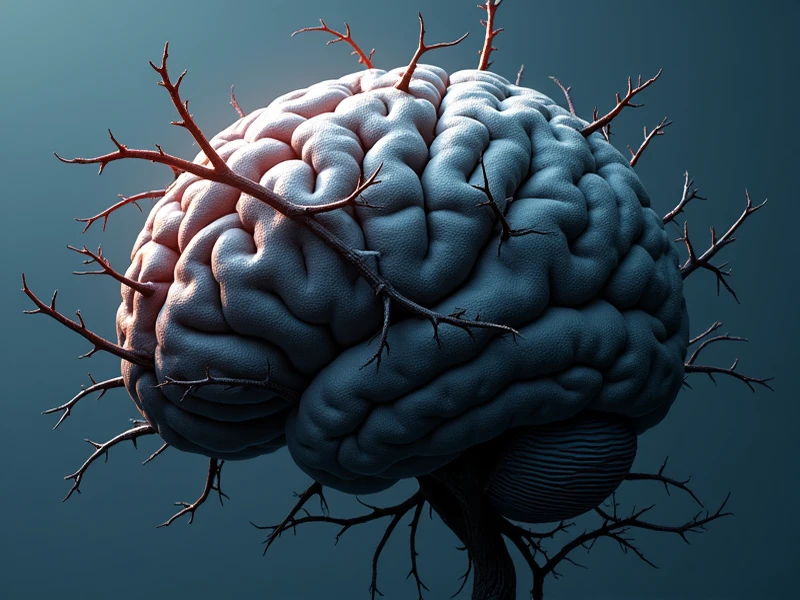3 Unrealistic Ways to Manage Anxiety or Overcome Depression

Introduction: The Rumination Trap

Anxiety and depression often lead individuals into a cycle of rumination鈥攁 repetitive, unproductive thought process that can exacerbate feelings of distress. Rumination involves dwelling on negative thoughts, worries, or memories, and it can significantly impact mental health. For many, including those like Trent, who struggled with Generalized Anxiety Disorder (GAD) and Obsessive-Compulsive Disorder (OCD), this mental habit can feel automatic and overwhelming. Instead of providing clarity or relief, rumination often deepens anxiety, making it crucial to recognize and address this counterproductive behavior.
Understanding Rumination and Its Role in Anxiety and Depression
Rumination vs. Intrusive Thoughts
To grasp the impact of rumination, it’s essential to differentiate it from intrusive thoughts. Intrusive thoughts are unwanted, often distressing ideas that can feel scary or obsessive. They disrupt daily life and can lead to significant anxiety. In contrast, rumination is a mental activity that occurs in response to these intrusive thoughts. It involves analyzing and rehashing worries in an attempt to find answers or reassurance.
Understanding this distinction is vital. While intrusive thoughts may arise unexpectedly, rumination can become a compulsive response that reinforces anxiety, particularly for those with OCD. For instance, Trent found himself ruminating about a false memory, trying to ascertain whether something terrible had occurred. This cycle of revisiting the thought only intensified his anxiety, illustrating how rumination can trap individuals in a loop of distress.
Why Rumination Doesn’t Work: It’s a Mental Compulsion
Rumination is not just a harmless habit; it actively reinforces anxiety and OCD cycles. As seen in Trent’s case, his attempts to resolve his worries through rumination only led to further anxiety. This behavior becomes a mental compulsion, where individuals feel compelled to analyze their thoughts, believing it will bring clarity or relief. Unfortunately, this often leads to a worsening of symptoms.
The repetitive nature of rumination creates a bad habit that can be challenging to break. Many individuals may not even realize they are ruminating until they are deep in thought. Recognizing this behavior is the first step toward breaking free from its grip.
The Problem-Solving Misconception
Many people mistakenly believe that rumination is a form of problem-solving. They think that by analyzing their worries, they can find solutions or answers. However, this approach is largely unproductive. Rumination mimics problem-solving but lacks the necessary elements of effective decision-making. Instead of leading to resolution, it often results in frustration and heightened anxiety.
Attempting to resolve unresolvable anxieties through analytical thinking can be futile. It’s essential to recognize that not all problems have clear solutions, and some anxieties may be better addressed through acceptance rather than analysis.
Unrealistic Management Techniques and Practical Alternatives
1. Trying to “”Figure It Out”” to Feel Less Anxious
One of the most unrealistic ways to manage anxiety is the belief that one can logically analyze their way out of distress. This approach often leads to more frustration and anxiety. Instead of seeking clarity, individuals may find themselves trapped in a cycle of overthinking.
A more effective strategy is Exposure and Response Prevention (ERP), particularly for those dealing with OCD. ERP encourages individuals to confront their fears and resist the urge to engage in compulsive behaviors, such as rumination. By facing anxieties head-on, individuals can gradually reduce their power and influence.
2. Perfect Control Over Thoughts and Sensations
Another unrealistic expectation is the belief that one can completely control their thoughts and sensations. Many individuals strive to eliminate intrusive thoughts entirely, which is an unattainable goal. Instead of fighting against these thoughts, a more beneficial approach is to practice acceptance and non-reactivity.
Learning to observe thoughts and sensations without judgment can significantly reduce their impact. This technique involves acknowledging the presence of intrusive thoughts without engaging with them. The “”Brain Hack for Anxiety and OCD”” video provides valuable insights into the I.M. method, which promotes this non-reactive approach.
3. Relying Solely on Medication without Behavioral Techniques
While medication can be an essential component of managing anxiety and depression, relying solely on it without incorporating behavioral techniques is unrealistic. Many individuals seek to manage anxiety and depression without medication, but this often requires a combination of therapeutic approaches.
Behavioral techniques, such as ERP, can enhance the effectiveness of medication and provide individuals with practical tools to manage their symptoms. Additionally, resources like the free ERP PDF for OCD and health anxiety can offer valuable guidance for those seeking alternative management strategies.

Practical Tips to Manage Anxiety and Stress
Mindfulness and Non-Reactivity
Practicing mindfulness can be an effective way to manage anxiety and stress. Mindfulness involves observing thoughts and feelings without judgment, allowing individuals to create space between themselves and their anxious thoughts. Techniques for staying non-reactive, especially at night when intrusive thoughts may arise, can help individuals maintain a sense of calm.
Problem-Solving vs. Acceptance
It’s essential to distinguish between solvable problems and those that are inherently unsolvable. Identifying solvable problems and addressing them practically can provide a sense of control. Conversely, accepting unsolvable anxieties and intrusive thoughts can lead to greater peace of mind. Acceptance does not mean resignation; rather, it involves acknowledging the presence of anxiety without letting it dictate one’s actions.
Resources and Further Help
For those seeking additional support, numerous resources are available. The free ERP PDF for OCD and health anxiety offers practical strategies for managing symptoms. Additionally, the “”Brain Hack for Anxiety and OCD”” video provides insights into effective techniques for overcoming anxiety.
Takeaways
- Recognize the difference between rumination and intrusive thoughts.
- Understand that rumination reinforces anxiety and OCD cycles.
- Accept that complete control over thoughts is unrealistic.
- Incorporate behavioral techniques alongside medication for effective management.
- Utilize mindfulness practices to enhance emotional regulation.
Q&A Section

Q: What are some effective strategies for managing anxiety without medication?
A: Effective strategies for managing anxiety without medication include practicing mindfulness, engaging in Exposure and Response Prevention (ERP), and utilizing problem-solving techniques for solvable issues. Additionally, acceptance of intrusive thoughts and seeking support through therapy or resources like ERP PDFs can significantly help individuals manage their anxiety.




